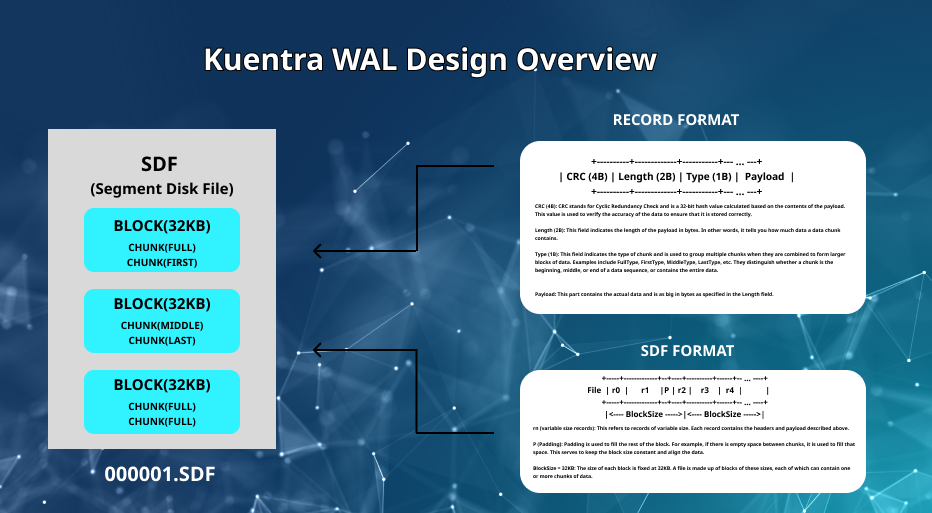Kuentra's Wal has a structure that is easy to understand and can be used for highly available databases.
WAL is not complex. It is simply a way to efficiently store files and read only the necessary data. Understanding the following four principles will enable you to build your own WAL system:
SegSerialIDBlockNumberChunkOffsetChunkSize
Think of these components as similar to the structural principles of MySQL.
Segment files can exist in multiples and may merge depending on the situation. They internally contain what are known as Blocks.
- Think of a segment as a Shard Table.
- Think of a block as just one of the many tables in a shard.
+-----------------------------------------------------+
| Segment File (SegmentID = 1) |
+-----------------------------------------------------+
| Block 0 | Block 1 | ... |
+-----------------------+-----------------------+-----+A block is composed of one or more chunks, akin to how a table contains one or more rows.
+-----------------------+
| Block 0 |
+-----------------------+
| Chunk 0 | Chunk 1 | ...|
+---------+---------+----+Each chunk is distinguished by ChunkOffset and ChunkSize, which you should not see as a single row but rather as limit and offset.
+-----------------------+
| Block 0 |
+-----------------------+
| C0 | C1 | C2 |
+---------+---------+----+
| Offset 0| Offset X| ...|
+---------+---------+----+
| Size Y | Size Z | ...|
+---------+---------+----+Consider this concept as inserting many documents into each shard table. The ChunkOffset represents the starting position of the document you are looking for, and ChunkSize represents the number of pages to the end. For instance, if a document starts at 0 and has 100 pages, it would be similar to the following SQL query:
SELECT * FROM SHARD_TABLE1 WHERE BLOCK_ID=0 OFFSET 0 LIMIT 100The same concept applies when writing data:
+-----------------------+
| Block 0 |
+-----------------------+
| C0 | C1 | C2 |
+---------+---------+----+
| Data | Data | Data|
+---------+---------+----+By knowing which shard table (SegSerialID) to insert into, the location, and the length, WAL can efficiently manage and retrieve data quickly and securely.
package main
import (
"io"
"log"
"github.com/kuentra-official/wal"
)
func main() {
walOpts := wal.DefaultOptions
walOpts.DirPath = "tmp"
kwal, err := wal.Open(walOpts)
if err != nil {
panic(err)
}
pos1, err := kwal.Write([]byte("first chunk"))
if err != nil {
panic(err)
}
rval1, err := kwal.Read(pos1)
if err != nil {
panic(err)
}
log.Println("Is this the expected value? Expect: [first chunk] return Value : [", string(rval1), "]")
_, err = kwal.Write([]byte("second chunk"))
if err != nil {
panic(err)
}
_, err = kwal.Write([]byte("third chunk"))
if err != nil {
panic(err)
}
reader := kwal.NewReader()
for {
rv, pos, err := reader.Next()
if err == io.EOF {
break
}
if err != nil {
panic(err)
}
log.Println("[pos] : ", pos, " [return value] : ", string(rv))
//must print first, second, third chunk
}
}